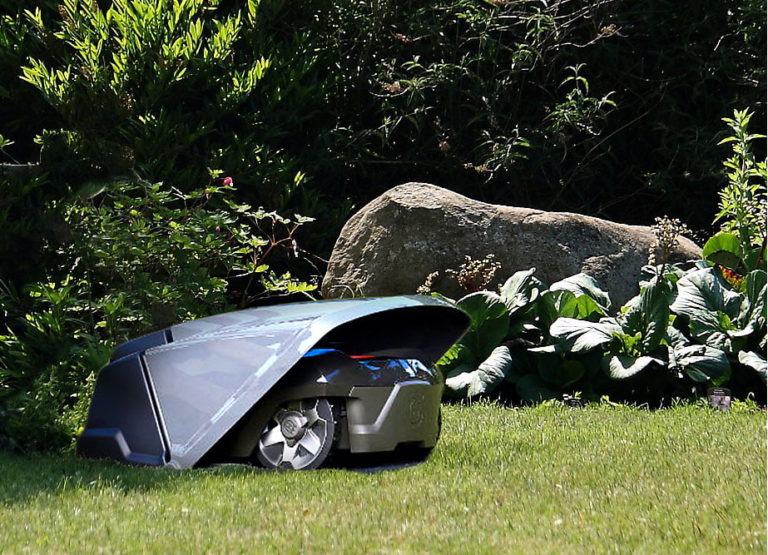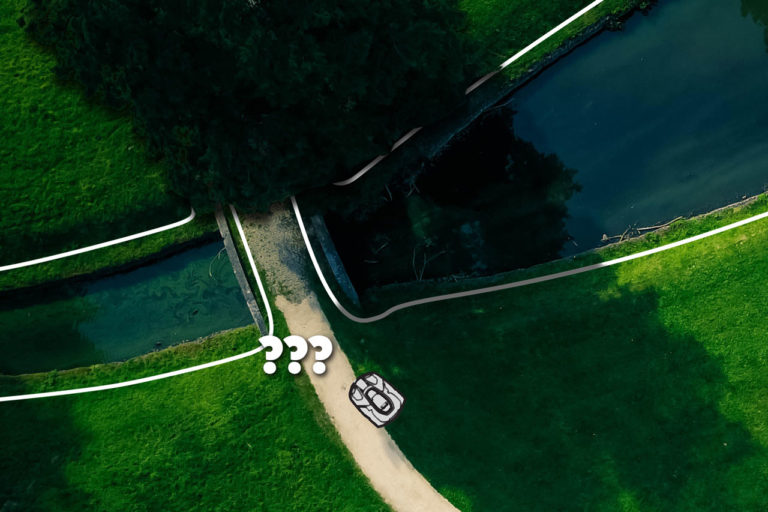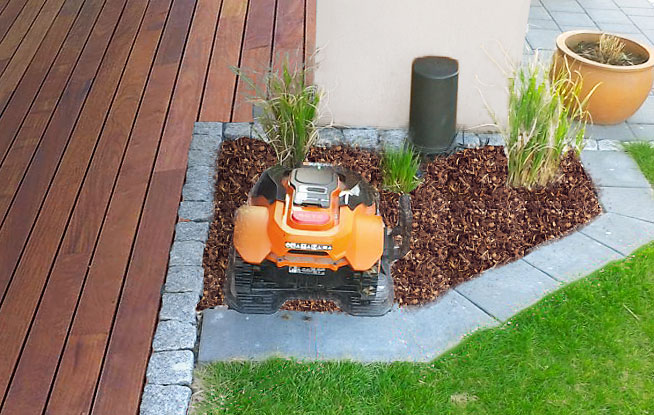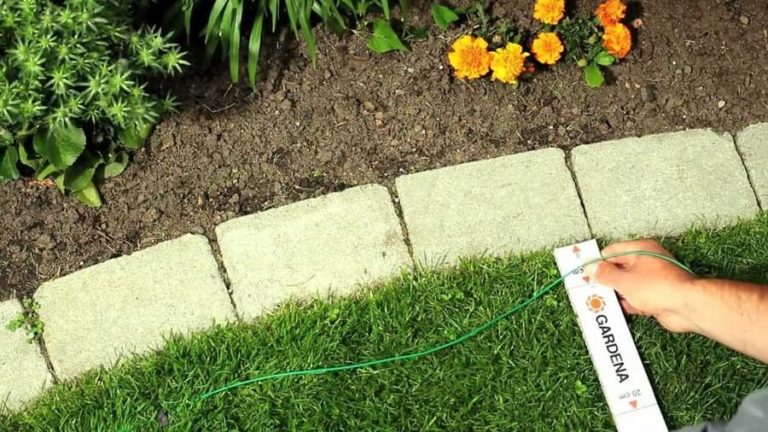Should you buy a robotic mower? Yes or no? If you are thinking about buying a robotic mower but are not sure yet, I can help you with this article. In this article I explain the advantages and disadvantages of a robotic mower and how you can make a decision. I will go into all the pros and cons to give you the best picture possible.
The advantages and disadvantages of a robotic mower at a glance
Advantages
Disadvantages
First I will explain the individual advantages and disadvantages in more detail to make your decision a little easier, because I think that not all of these points are obvious. Then I will give you a few tips on how you can decide whether a robotic mower is worthwhile for you or not.
Contents
Robotic mowers save time (Pro)
To get a really good idea of how much time you actually save, I’ll compare the robotic mower version with that of a normal lawnmower.
The work that is required for a normal lawn mower includes the actual mowing of the lawn and emptying the catch basket. This is done on average 34 weeks a year for about 1 hour, i.e. 34 hours. A further 14 hours are estimated for getting the lawn mower ready and putting it away afterwards, unrolling and rolling up the power cable, disposing of cuttings and cleaning the machine. This makes a total of 48 working hours per year.
The robotic mower must be installed in the first year. This means that the boundary wire must be laid, the charging station must be set up and the robotic mower must be correctly adjusted. In the first few weeks there may be some repairs where the robotic mower has problems mowing. Here you can estimate 4 to 6 working hours.
Care and maintenance of the mower are also important. The robotic mower must be cleaned from time to time and the blades must be replaced. Many robotic mowers now use revolving discs with small free-swinging blades, which are replaced every 1 to 3 months. There are also robotic mowers with a star-shaped mowing cross, which only needs to be replaced once per season. Altogether, this makes up about 4 working hours.
In total, maintenance time between the two is:
- Lawn mowers: approx. 48 working hours (every year)
- Robotic mower. up to 10 working hours (in the first year), thereafter 4 working hours per year
The time saved is therefore significant, especially in subsequent years when the effort of installation is no longer required. For larger areas that take longer to mow, the whole thing is multiplied again.
The purchase price of robotic mowers is high (Con)
In the US the costs for a robotic mower start at around $800 in the lower price range and can even exceed $5,000 in the higher price range. For most lawns, however, a suitable robotic mower will cost around $1,500. However, this depends on various factors, including:
- Size of the property
- Complexity of the property
- Equipment of the robotic mower
- Quality of the robotic mower
The size of the property is probably the biggest influence on the price. The larger the plot, the larger and more powerful the robotic mower must be. There are robotic mowers that only mow very small areas of up to 200 square meters. Others are designed for much larger areas of ½ acre or more. For gigantic areas there are even robotic mowers that can manage 7 ½ acres.
The manufacturers’ specifications for area output usually assume that the robotic mower is in continuous operation for 15 hours every day from Monday to Friday. It is important to note before purchasing your mower that this is unrealistic in most cases.
In the article How long does it take a robotic mower to mow your lawn you can read all about the area output. At the bottom of the page there is a calculator with which you can calculate the area output you need.
An electric lawnmower plus power cable usually costs around $250,and a gas-powered mower just over $300. In terms of purchase costs, these are of course much cheaper.
- Lawn mower: $250 – 300
- Robotic mower: approx. $1500
So the point in terms of acquisition costs goes to the ordinary lawnmower.
However, if you take into account the long-term cost and pay yourself a salary for your lawn mowing efforts, a robotic mower will pay for itself after some time.
Robotic mowers have lower operating costs (Pro)
A robotic mower saves some operating costs compared to normal lawnmowers. On the one hand, its energy consumption is lower, even though it stays on the lawn for much longer. You also save money through cheaper and easier blade replacement. In addition, you can save a good portion of the fertilizer that would otherwise be necessary to keep the lawn healthy. About 30% of the fertilizer can be saved, sometimes even more. The operating costs can be similar to those of a normal lawnmower:
- Electric lawn mower: $220
- Gas-powered lawn mower: $280
- Robotic mower: $120
Robotic mowers require more maintenance than normal lawnmowers (Con)
Since robotic mowers are constantly in use, they also have to be cleaned a little more often than normal lawnmowers. In addition, the blades of robotic mowers with blade discs must be replaced approximately every 1 to 3 months. In addition, it can happen from time to time that something goes wrong with the machine, in which case you must first correct the problem.
For example, the boundary wire may break if you accidentally hit it with a shovel, for example. In this case, you must first look for the place and then repair it. Or something is wrong with the electronics. On the other hand, it must be said that many early complications have been eradicated with time in the company.
Robotic mowers work more quietly than normal lawnmowers (Pro)
While conventional lawnmowers can be as loud as 80 decibels or even up to 100 decibels, robotic mowers typically operate between 55 and 75 decibels, with the majority of robotic mowers operating at around 65 decibels.
This is not only good for the nerves and the neighbors. The particularly quiet robotic mowers are even so quiet that you can sometimes let them work at night. How great is it when you wake up in the morning with a freshly mown lawn in front of you?
If you want to know more about the noise level of robotic mowers, I have written a very extensive article about it.
The installation of a robotic mower is complex (Con)
The installation of a robotic mower involves a certain amount of effort. It is unfortunately a little more complicated than plugging it in and letting it go do its thing. It also depends on whether you have a robotic mower with or without boundary wire.
Robotic mower with a boundary wire
Most manufacturers rely on robotic mowers with boundary wires. In addition to the boundary wire, there is also a charging station and often one or more guide wires that have to be installed. The boundary and guide wires have to be buried just below the grass, which can be quite complex. A suitable place for the charging station must be found. It must be anchored in the ground with special hooks or screws, but this usually does not take too long.
Last but not least, the robotic mower must still be correctly adjusted. Many robotic mowers already have certain standard settings at the beginning, with which they then mow the lawn. However, you may want to use different settings, for example because you only want the robotic mower to mow in the morning. Or you want to turn off the rain sensor for certain reasons. You will then have to set all these settings first.
Robotic mower without boundary wire
Models that operate without a boundary wire require almost no installation effort. As a rule, you simply set up such a robotic mower on your lawn, switch it on and off you go. The mower recognizes the limits of the lawn with a grass sensor. They have some advantages and disadvantages compared to robotic mowers with boundary wire. But probably the biggest advantage is that they have little or no installation effort.
It may just be that you need to adjust some small things in your garden so that the robotic mower can drive safely. For example, if you have a pool or pond in your garden, when using a robotic mower without a boundary wire, you should always enclose the water surface with a barrier to prevent the robotic mower from accidentally driving into it (the grass sensor is not as reliable as a boundary wire). There may also be other places in your yard where you want to install a barrier for safety reasons, for example to prevent the robotic mower from driving over the flower bed.
Robotic mowers are more cost efficient in the long run (Pro)
Although robotic mowers have a significant initial cost, they are more cost-efficient in the long run. However, this is only true if the working time is taken into account. I have already shown you above that the operating costs are significantly lower than for normal lawnmowers. Here again the comparison of the annual cost of operating:
- Electric lawn mower: $220
- Gas-powered lawn mower: $280
- Robotic mower: $120
At the same time, robotic mowers cost around $1500 and conventional lawnmowers between $250 and $300, as I have mentioned above. So if the robotic mower is $1200 more expensive and costs $160 less per year, it would take almost 7.5 years for the investment to pay off. Admittedly quite a long time.
But if you would pay yourself a wage of $10 for mowing the lawn and maintaining the lawn mower or robot, things would look quite different. The following diagram compares the cost development of different price ranges of robotic mowers with conventional lawn mowers.
Some robotic mowers have problems with very steep slopes (Con)
Extreme gradients make robotic mowers work hard. They are simply not made for very steep slopes. Either they can’t make it up the slope at all, they slip off of it, or their wheels begin spinning, which in turn damages the turf. Especially when it is wet, the grass is slippery, the ground is softened, or there are a lot of leaves in the yard, problems can occur.
However, most robotic mowers can cope with gradients of up to 25%. Meanwhile, there is already a very large number of robotic mowers that easily cope with 35%. At this point, the range of models offered is starting to diminish. But the manufacturer Husqvarna still supplies a very large range of robotic mowers that can cope with gradients up to 45%.
An accessory off-road kit can provide even more grip, so that the robotic mower does not slip so easily and can manage even greater gradients. Another way you can give the robotic mower more grip on steep places and prevent the lawn from being damaged by spinning wheels is to use so-called lawn guards.
However, Husqvarna robotic mowers also tend to be significantly more expensive than the equipment of other manufacturers. There are also a few models from other manufacturers that can handle over 50% gradients, but these are hard to find.
Robotic mowers can certainly cope with some gradients, if they are not too steep. From a certain gradient on, however, this ability is also reflected in the price of the equipment. Anything that manages over 35% also costs correspondingly more.
Thanks to the mulching system you have less yard waste (Pro)
The robotic mower mulches the lawn as it goes. During mulching, the lawn cuttings are not collected, but remain on the lawn and decompose, so that their nutrients can be returned to the lawn.
However, lawn cuttings cannot simply be left on the lawn, as this could cause thatching and impair ventilation, and the lawn cuttings could even start to rot. This is why robotic mowers only ever cut off a very small tip of the lawn. They achieve this by mowing frequently, at least every other day.
These very fine lawn tips cannot mat together on the lawn, and they weather very quickly. This has two advantages. Firstly, you do not have to worry about the disposal of the lawn clippings and therefore have more space for other waste in the compost bin, for example. On the other hand, the lawn is continuously fertilized and thus becomes lusher and greener. Last but not least, you save about 30% of the fertilizer that you should use on the lawn throughout the year.
Complex gardens require particularly expensive robotic mower models (Con)
With a simple, rectangular garden, any robotic mower can cope quite well. But as soon as the yard introduces strange angles and slopes, with many areas connected only by narrow passages, it can no longer be guaranteed that a simple robotic mower can mow each area often enough. It may not reach some places at all, or it may get stuck in certain places.
Such gardens require equipment with more advanced navigation systems. These are for example
- Bottleneck circuit
- Multi-Zones
- GPS navigation
Devices with multi-zone circuitry are among the cheapest models, while devices with adaptive circuitry are somewhat more expensive, and you have to dig deep into your pocket for GPS-supported robotic mowers. Some devices also combine these systems.
Robotic mowers produce a cleaner cutting pattern (Pro)
The fact that robotic mowers mow very frequently and regularly and that they navigate the area according to the chaos principle, results in a very even and clean cut.
It may not be obvious to you at first glance why the chaos principle leads to a cleaner cut. The reason is that unlike mowing with a normal mower, the lawn is cut from all directions. As a result, it is not always “combed” in one direction, and there are also no stripes caused by straight mowing or marks in the places where the mower is regularly driving along.
In addition, frequent pruning ensures that the lawn grows better, but more about this later.
At the beginning operating a robotic mower requires some adjustment time (Con)
A robotic mower is a complex piece of equipment. First, you have to deal with the installation of the device itself (for robots with boundary wire), and later with the operation and configuration.
Many robotic mowers now even come with an app with which the mower can be configured. I think this makes configuration easier than if you had to operate it on a small display on the device.
Many machines also come with presets for things such as mowing times, which you can adjust individually, but you don’t have to. You should expect a little adjustment time at the beginning, but in most cases this is rather limited. It also depends on how complex the property is, for example, and how much configuration you have to do.
Besides, the whole thing can be quite fun if you are interested in the device. Whether this can be considered a strong (if any) negative point depends on the individual person.
Through mulching and regular, frequent mowing, the lawn becomes healthier (Pro)
As I mentioned above, mulching continuously provides the lawn with new fertilizer, which makes it grow better and healthier. Because of the better growth, weeds and grasses that are more adapted to poorer soils have a harder time spreading.
Utility turf varieties are also adapted to frequent cutting and their blades become wider in response. As a result, the lawn becomes stronger and can also assert itself better against foreign plants.
Last but not least, frequent mowing does not benefit other plants. Some weeds, in particular, are less able to spread because they cannot develop their flowers. These are always cut away before they can blossom. Of course this may not be the case with all weeds, but it is true for many weed varieties. Grass, on the other hand, does not have to grow very high to spread.
However, the decreasing populations of weeds is a very slow process, which sometimes only becomes really visible after a few seasons and should be supported by other anti-weed measures.
With many robotic mower models the lawn edge must be trimmed elsewise (Con)
One problem that many robotic mowers have is that they do not cut all the way to the edge. There is a certain distance between the body and the mowing unit, which is quite large for safety reasons, so that, for example, if a foot gets under the mower, there is at least a little room to maneuver before it gets into the blade’s path.
Because of this margin, the mower must, in theory, always drive a little over the edge of the lawn at the edges in order to mow it completely. Of course, this is not possible everywhere if an obstacle, e.g. a house wall, flower bed or hedge is in the way. The robotic mower will then bump into the obstacle or you have laid the boundary wire so that it does not bump into the obstacle, but cannot mow the lawn to the edge.
However, there are robotic mowers that have a so-called edge mowing function. In edge mowing mode, these models drive along the outside of the boundary wire and mow the edge. Because their mowing unit is slightly offset, they can also mow very close to the edge.
Another possibility is to border the lawn on the outside with ground level lawn edging stones on which the robotic mower can drive a slight bit. This enables the robot to mow right up to the edge, even if it does not have an edge mowing function.
Unlike gas-powered mowers, robotic mowers do not produce local emissions (Pro)
One advantage that robotic mowers share with electric lawnmowers is that they do not produce exhaust fumes (at least not in your yard, of course the electricity has to be generated somehow, which produces emissions). This is of course an advantage compared to gas-powered mowers, because there is no annoying smell and air spoilage. This is good for both nature and your own health.
Robotic mowers offer an increased risk potential for humans and animals (Con)
Just like normal lawnmowers, robotic mowers with sharp blades work under a shell and framework which neither humans nor animals can get underneath. Robotic mowers try to keep the danger potential as low as possible with a lot of safety systems, but it still represents a certain accident risk that a rotating blade disc drives around in the area quasi uncontrolled.
Both children and pets or other inhabitants of the yard, such as wild rabbits, can be injured by the robotic mower. However, this risk can be minimized by setting suitable mowing times. For example, you can let the robotic mower mow in the morning while the children are not in the house or your dog and cat are inside. Many small animals are also usually not out in the yard at this time of day.
You can read more about how dangerous robotic mowers are for children, what the manufacturers are doing to make them safer and what you can do yourself to minimise the risk of accidents here: Are robotic mowers dangerous to children?
Robotic mowers are particularly suitable for people with grass pollen allergies (Pro)
Anyone who is allergic to grass pollen is particularly well advised to use the appropriate robotic mower. Mowing with a conventional lawnmower will stir up a lot of grass pollen, while you are naturally on the lawn to control the mower.
Firstly, a robotic mower does not swirl up grass pollen as much and secondly, you can stay away while mowing the lawn. This is a big advantage for allergy sufferers who suffer from allergies when mowing the lawn because of all the grass pollen.
Lawn robots can be stolen (Con)
Lawn robots are expensive devices, much more expensive than a normal robotic mower and are outside in the garden day and night, freely accessible to anyone who can gain access to the garden. This of course also involves a certain risk of theft. Although robotic mowers are equipped with a whole range of anti-theft functions, from a simple alarm signal when the robotic mower is lifted by unauthorized persons, to tracking the device via GPS, you are not 100% safe from theft.
However, there are many other measures you can take to protect your robotic mower from theft, such as theft-proof rolling shutter garages or underground car parks.
Here you can learn more about how to protect your robotic mower from theft.
People with walking disabilities no longer have to bother with mowing the lawn (Pro)
Robotic mowers can make life easier for people with walking disabilities by relieving them of the work of mowing the lawn. For all those who can no longer walk so well, whether due to age, injury, or physical disability, this is definitely a great advantage.
However, the robotic mower does not run all by itself; from time to time it must be cleaned and the blades must be replaced. If the owner is also no longer able to do this, this should be done by another person at regular intervals.
Robotic mowers cannot mow separate areas alone (Contra)
Two separate lawns are no problem with a normal lawnmower. When you’re done, just unplug, move the mower to the other lawn, plug it in, and off you go!
With a robotic mower you have a little problem here. Without a connection, the robotic mower cannot drive to the other area to mow. With robotic mowers without boundary wire you can simply carry it over (they need some care anyway).
However, with a robotic mower with boundary wire, you cannot mow two completely separate areas in this way. The robotic mower must return to the charging station at regular intervals to recharge. That means you would need a charging station in the second area, as well. However, the robotic mower cannot be installed at two different charging stations at the same time. This means that you would need another robotic mower for the second area. Ergo: A robotic mower with boundary wire cannot mow two separate areas.
The term “separated” really means here that there is absolutely no connection that the robotic mower can use. For example, if there is a sidewalk or the like, you can set up a bottleneck circuit which the robotic mower then uses to drive to the other area.
Even on vacation your lawn will always be mowed (Pro)
Even when you go on vacation, you can still use your robotic mower, so your lawn is freshly mowed when you come home and you don’t have half a forest in your yard. This is also better for your lawn, because if it is not mowed for several weeks, it can have a negative effect – albeit small – on the health of the lawn.
In addition, if the lawn is not mowed during the vacation, special lawn care rules must be observed, such as the one-third rule – which you can then ignore, however, because the lawn has been mowed diligently while you were away.
Toys and garden tools must always be removed from the lawn prior to mowing avoid damage (Con)
Although a robotic mower has sensors with which it detects certain obstacles, not everything that lies around on the lawn is recognized as an obstacle. Gardening tools like rakes or shovels can be run over and the same applies to toys in the yard.
This can damage the objects themselves as well as the mowing unit of the robotic mower. Therefore, it is important to make sure that there are no objects lying around in the yard that could be run over by the robotic mower. After a while, however, it becomes an automatic process for everyone to take care of this and you will automatically remember to clear away everything that could get under the blades.
How do you decide whether you should buy a robotic mower?
Ultimately, the question is what makes you want to buy a robotic mower in the first place, and what is most likely to prevent you from buying one. Now that you know all the pros and cons of a robotic mower, the decision should be a little easier. Especially with the disadvantages there are some points where you can take countermeasures, as I have described above.
For example, the risk of accidents for families with children is usually not a real problem if you only let the robotic mower drive in the mornings during the week and choose a device that is large enough to cope with the same area in a shorter time.
Some people also consider whether the robotic mower can cope in their yard. Of course, a more complex garden needs a device that can find its way around, be it through a multi-zone function or GPS navigation, but in most yards a robotic mower can work. Only in extreme cases, such as when your lawn has extreme slopes of over 50% gradient, would a robotic mower make little sense.





